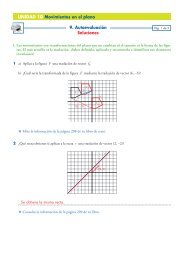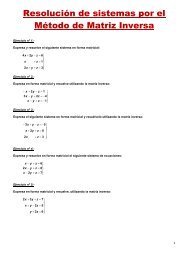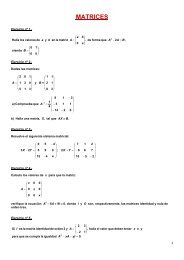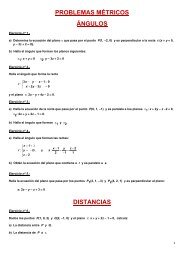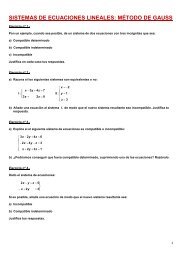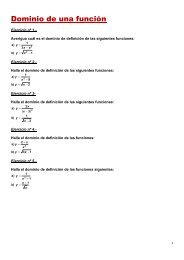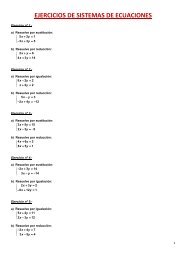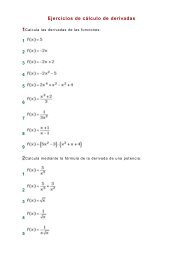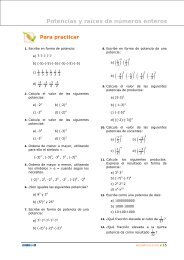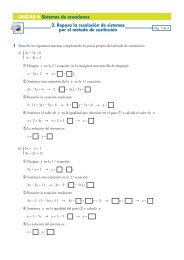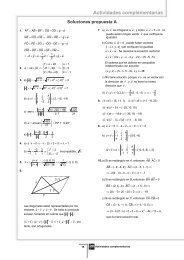Ejercicios de polinomios - Amolasmates
Ejercicios de polinomios - Amolasmates
Ejercicios de polinomios - Amolasmates
You also want an ePaper? Increase the reach of your titles
YUMPU automatically turns print PDFs into web optimized ePapers that Google loves.
<strong>Ejercicios</strong> <strong>de</strong> <strong>polinomios</strong><br />
1 Indica cuales <strong>de</strong> las siguientes expresiones son monomios. En caso afirmativo, indica su grado y<br />
coeficiente.<br />
13x 3 25x −3 33x + 1 √2 <br />
2 Efectúa las siguientes operaciones con monomios:<br />
1 2x 3 − 5x 3 =<br />
2 3x 4 − 2x 4 + 7x 4 =<br />
3 (2x 3 ) · (5x 3 ) =<br />
4 (2x 3 y 2 ) · (5x 3 y z 2 ) =<br />
5 (12x 3 ) · (4x) =<br />
6 (18x 3 y 2 z 5 ) · (6x 3 y z 2 ) =<br />
7 (2x 3 y 2 ) 3 =<br />
8 (2 x 3 y 2 z 5 ) 5 =<br />
9 3x 3 − 5x 3 − 2x 3 =<br />
10 (12 x 3 y 5 z 4) : (3x 2 y 2 z 3 ) =<br />
11<br />
<br />
3 Di si las siguientes expresiones algebraicas son <strong>polinomios</strong> o no. En caso afirmativo, señala cuál es su grado<br />
y término in<strong>de</strong>pendiente.<br />
1 x 4 − 3x 5 + 2x 2 + 5<br />
2 2 + 7X 2 + 2<br />
3 1 − x 4<br />
4<br />
5 x 3 + x 5 + x 2<br />
6 x − 2 x − 3 + 8<br />
7<br />
<br />
<br />
2√
4 Escribe:<br />
1 Un polinomio or<strong>de</strong>nado sin término in<strong>de</strong>pendiente.<br />
2 Un polinomio no or<strong>de</strong>nado y completo.<br />
3 Un polinomio completo sin término in<strong>de</strong>pendiente.<br />
4 Un polinomio <strong>de</strong> grado 4, completo y con coeficientes impares.<br />
5 Dados los <strong>polinomios</strong>:<br />
P(x) = 4x 2 − 1<br />
Q(x) = x 3 − 3x 2 + 6x − 2<br />
R(x) = 6x 2 + x + 1<br />
S(x) = 1/2x 2 + 4<br />
T(x) = 3/2x 2 +5<br />
U(x) = x 2 + 2<br />
Calcular:<br />
6 Multiplicar:<br />
1 P(x) + Q (x)<br />
2 P(x) − U (x)<br />
3 P(x) + R (x)<br />
4 2P(x) − R (x)<br />
5 S(x) + R (x) + U(x)<br />
6 S(x) − R (x) + U(x)<br />
1 (x 4 −2x 2 +2 ) · (x 2 −2x +3) =<br />
2 (3x 2 − 5x) · (2x 3 + 4x 2 − x +2) =<br />
7 Calcula:<br />
1<br />
2 (x + 2) 3<br />
3 (3x - 2) 3
4 (2x + 5) 3<br />
5 (3x - 2) · (3x + 2)<br />
8 Dividir:<br />
(x 4 − 2x 3 −11x 2 + 30x −20) : (x 2 + 3x −2)<br />
9 Divi<strong>de</strong> por Ruffini:<br />
(x 3 + 2x +70) : (x+4)<br />
10 Halla el resto <strong>de</strong> las siguientes divisiones:<br />
1 (x 5 − 2x 2 − 3) : (x −1)<br />
2 (2x 4 − 2x 3 + 3x 2 + 5x +10 ) : (x + 2)<br />
11 Indica cuáles <strong>de</strong> estas divisiones son exactas:<br />
1 (x 3 − 5x −1) : (x − 3)<br />
2 (x 6 − 1) : (x + 1)<br />
3 (x 4 − 2x 3 + x 2 + x − 1) : (x − 1 )<br />
4 (x 10 − 1024) : (x + 2)<br />
12 Comprueba que los siguientes <strong>polinomios</strong> tienen como factores los que se indican:<br />
1 (x 3 − 5x −1) tiene por factor (x − 3)<br />
2 (x 6 − 1) tiene por factor (x + 1)<br />
3 (x 4 − 2x 3 + x 2 + x − 1) tiene por factor (x − 1 )<br />
4 (x 10 − 1024) tiene por factor (x + 2)<br />
13 Factorizar:<br />
1<br />
2 xy − 2x − 3y +6 =<br />
3 25x 2 − 1=<br />
4 36x 6 − 49 =<br />
5 x 2 − 2x +1 =
6 x 2 − 6x +9 =<br />
7 x 2 − 20x +100 =<br />
8 x 2 + 10x +25 =<br />
9 x 2 + 14x +49 =<br />
10 x 3 − 4x 2 + 4x =<br />
11 3x 7 − 27x =<br />
12 x 2 − 11x + 30<br />
13 3x 2 + 10x +3<br />
14 2x 2 − x −1<br />
14 Descomponer en factores y hallar las raíces <strong>de</strong>:<br />
1 P(x) = 2x 3 − 7x 2 + 8x − 3<br />
2 x 3 − x 2 − 4<br />
3 x 3 + 3x 2 −4 x − 12<br />
15 Encontrar el valor <strong>de</strong> k para que al dividir 2x 2 − kx +2 por (x − 2) dé <strong>de</strong> resto 4.<br />
16 Determinar el valor <strong>de</strong> m para que 3x 2 + mx + 4 admita x = 1 como una <strong>de</strong> sus raíces.<br />
17 Hallar un polinomio <strong>de</strong> cuarto grado que sea divisible por x 2 − 4 y se anule para x = 3 y x= 5.<br />
18 Calcular el valor <strong>de</strong> a para que el polinomio x 3 − ax + 8 tenga la raíz x= −2, y calcular las otras raíces.<br />
19 Simplificar:<br />
1<br />
2<br />
3<br />
4
20 Operar:<br />
1<br />
2<br />
3<br />
4<br />
5
SOLUCIONES<br />
1 Indica cuales <strong>de</strong> las siguientes expresiones son monomios. En caso afirmativo, indica su grado y<br />
coeficiente.<br />
13x 3<br />
Grado: 3, coefeciente: 3<br />
25x −3<br />
No, porque el exponente no es un número natural.<br />
33x + 1<br />
No, porque aparece una suma.<br />
√2<br />
Grado: 1, coefeciente: √ 2<br />
3<br />
4 <br />
3<br />
Grado: 4, coefeciente: <br />
4<br />
3<br />
<br />
No, no tiene exponente natural.<br />
2√<br />
No, porque la parte literal está <strong>de</strong>ntro <strong>de</strong> una raíz.<br />
2 Efectúa la siguientes operaciones con monomios:<br />
3 3 3<br />
2x − 5x = −3x<br />
4 4 4<br />
3x − 2x + 7x = 8x 4<br />
3 3 6<br />
(2x ) · (5x) = 10x<br />
3 2<br />
(12x ) : (4x) = 3x<br />
6 2 5 3<br />
(18x y z ) : (6x y z 2 ) = 3x 3 y z 3<br />
3 2 3 9 6<br />
(2x y ) = 8 x y<br />
3 2 5 5 15<br />
(2 x y z ) = 32 x y 10 z 25
3x 3 − 5x 3 − 2x 3 = −4x 3<br />
(12 x 3 y 5 z 4 ) : (3x 2 y 2 z 3 ) = 4xy 3 z<br />
3 Di si las siguientes expresiones algebraicas son <strong>polinomios</strong><br />
o no. En caso afirmativo, señala cuál es su<br />
grado<br />
y término in<strong>de</strong>pendiente.<br />
1x 4 − 3x 5 + 2x 2 + 5<br />
Grado: 5, término in<strong>de</strong>pendiente:<br />
5.<br />
22 + 7X 2 + 2<br />
No, porque<br />
la parte<br />
31 − x 4<br />
Grado: 4,<br />
término in<strong>de</strong>pendiente: 1.<br />
4<br />
literal <strong>de</strong>l primer monomio está <strong>de</strong>ntro <strong>de</strong> una raíz.<br />
N o, porque el exponente<br />
<strong>de</strong>l primer monomio no es un número natural.<br />
5x 3 + x 5 + x 2<br />
Grado: 5, término<br />
in<strong>de</strong>pendiente: 0.<br />
x − 2x −3 + 8<br />
No, porque el exponente <strong>de</strong>l 2º monomio no es un número natural.<br />
7<br />
Grado: 5, término in<strong>de</strong>pendiente: -7/2.<br />
4 Escribe:<br />
1 Un polinomio<br />
or<strong>de</strong>nado sin término in<strong>de</strong>pendiente.<br />
3x 4 − 2x<br />
2 Un polinomio<br />
no or<strong>de</strong>nado y completo.<br />
x − x 2 + 5 − 2x 3<br />
3 Un polinomio completo<br />
sin término in<strong>de</strong>pendiente.
Imposible<br />
4 Un polinomio<br />
<strong>de</strong> grado 4, completo y con coeficientes impares.<br />
5 Dad<br />
x 4 − x 3 − x 2 + 3x + 5<br />
os los <strong>polinomios</strong>:<br />
P(x) = 4x 2 − 1<br />
Q(x) = x + 6x − 2<br />
3 − 3x 2<br />
R(x) = 6x 2 + x + 1<br />
S(x) = 1/2x 2 + 4<br />
T(x) = 3/2x 2 +5<br />
U(x) = x 2 + 2<br />
Calcular:<br />
1 P(x)<br />
+ Q (x) =<br />
4x 2 − 2) = x 3 − 3x 2 + 4x 2 + 6x − 2 − 1 = x 3 + x 2 = ( − 1) + ( x + 6x − 3<br />
3 − 3x 2 + 6x<br />
2 P(x) − U (x) = (4x 2 − 1) − (x 2 + 2) = 4x 2 − 1 − x 2 − 2 = 3x 2 − 3<br />
10x 2 3 P(x) + R (x) = (4x + x<br />
2 − 1) + (6x 2 + x + 1) = 4x 2 + 6x 2 + x − 1 + 1 =<br />
4 2P(x) − R (x) = 2(4x 3<br />
2 − 1) - (6x 2 + x + 1) = 8x 2 − 2 − 6x 2 − x − 1 = 2x 2 − x −<br />
5 S(x) + R (x) + U(x) = (1/2 x + 4 + 5+ 2 =<br />
2 + 4 ) + (3/2 x 2 +5 ) + (x 2 + 2) = 1/2 x 2 + 3/2 x 2 + x 2<br />
= 3x 2 + 11<br />
6 + U(x) = (1/2 x 2 + 4 ) − (3/2 x 2 +5 ) + (x 2 + 2) = 1/2 x 2 + 4 − 3/2 x 2 − 5 + x 2 S(x) − R (x)<br />
+ 2 = 1<br />
6 Multiplicar:<br />
· (x 2 −2x +3) = x 6 −2x 5 + 3x 4 − 2x 4 + 4x 3 − 6x 2 + 2x 2 1 (x − 4x +6=<br />
4 −2x 2 +2 )<br />
= x x + 6<br />
6 −2x 5 − 2x 4 + 3x 4 + 4x 3 + 2x 2 − 6x 2 − 4x +6 x 6 −2x 5 + x 4 + 4x 3 − 4x 2 − 4<br />
2 (3x =<br />
2 − 5x ) · (2x 3 + 4x 2 − x +2) = 6x 5 + 12x 4 − 3x 3 + 6x 2 − 10x 4 − 20x 3 + 5x 2 − 10x<br />
= 6x 5 + 12x 4 − 10x 4 − 3x 3 − 20x 3 + 6x 2 + 5x 2 − 10x = 6x 5 + 2x 4 − 23x 3 + 11x 2 − 10x
7 Calcula:<br />
1<br />
2<br />
(x + 2) 3 = x 3 + 3 · x 2 ·2 + 3 · x· 2 2 + 2 3 = x 3 + 6 x 2 + 12 x + 8<br />
3 2 2 3 3 2<br />
3 (3x - 2) − 8<br />
3 = (3 x) − 3 · (3x) ·2 + 3 · 3x· 2 − 2 = 27x − 54 x + 36 x<br />
8 Dividir:<br />
2 2 2<br />
1x 2 + 30x −20) : (x 2 (x + 3x −2)<br />
4 − 2x 3 −1<br />
10 Halla el resto <strong>de</strong> las siguientes divisiones: 4 2<br />
2 (2x − 2x +10 ) : (x + 2)<br />
3 + 3x + 5x<br />
2 3 2<br />
4 (2x + 5) 3 = (2 x) 3 + 3 ·(2x) 2 ·5 + 3 · 2x· 5 + 5 3 = 8x + 60 x + 150 x + 125<br />
5 (3x - 2) · (3x + 2) = (3x) − 2 = 9x − 4<br />
9 Divi<strong>de</strong> por Ruffini:<br />
(x 3 + 2x +70) : (x+4)<br />
1 (x 5 − 2x 2 − 3) : (x −1)<br />
5 2<br />
R(1) = 1 − 2 · 1 − 3 = −4
R(−2) = 2 · (−2) 4 − 2· (−2) 3 + 3· (−2) 2 + 5· (−2) +10 = 32 + 16 + 12 − 10 + 10 = 60<br />
1<br />
1 Indica cuáles <strong>de</strong> estas divisiones son exactas:<br />
1 (x 3 − 5x −1) : (x − 3)<br />
P(3) = 3 − 1 ≠ 0<br />
3 − 5 · 3 − 1 = 27 − 15<br />
No es exacta.<br />
2 (x : (x + 1)<br />
6 − 1)<br />
P(−1)= (-1) 6 − 1 = 0<br />
Exacta<br />
x 4 − 2x 3 + x 2 3 (<br />
+ x − 1) : (x − 1 )<br />
P(1) = 1 +1 − 1 = 0<br />
4 − 2 · 1 3 + 1 2 + 1 − 1 = 1 − 2 +1<br />
Exacta<br />
10<br />
4 (x − 1024) : (x + 2)<br />
P(−2) = (−2) − 1024 =<br />
10 − 1024 = 1024<br />
Exacta<br />
12 Com<br />
prueba que los siguientes <strong>polinomios</strong> tienen como factores los que se indican:<br />
1 (x 3 − 5x −1) tiene por factor (x − 3)<br />
(x si P(x = 3) = 0.<br />
3 − 5x −1) es divisible por (x − 3) si y sólo<br />
P(3) = 3 3 − 5 · 3 − 1 = 27 − 15 − 1 ≠ 0<br />
(x − 3) no es un factor.<br />
2 (x factor (x + 1)<br />
6 − 1) tiene por<br />
(x si P(x = − 1) = 0.<br />
6 − 1) es divisible por (x + 1) si y sólo<br />
P(−1) = (−1) 6 − 1 = 0<br />
(x + 1) es un factor.<br />
3 (x − 1) tiene por factor (x − 1 )<br />
4 − 2x 3 + x 2 + x<br />
(x si P(x = 1) = 0.<br />
4 − 2x 3 + x 2 + x − 1) es divisible por (x − 1 ) si y sólo<br />
P(1) = 1 4 − 2 · 1 3 + 1 2 + 1 − 1 = 1 − 2 +1 +1 − 1 = 0
(x − 1) es un factor.<br />
4 (x 10 − 1024) tiene por factor (x + 2)<br />
(x si P(x = − 2) = 0.<br />
10 − 1024) es divisible por (x + 2) si y sólo<br />
P(−2) = (−2) 10 − 1024 = 1024 − 1024 =<br />
(x + 2) es un factor.<br />
13 Factorizar:<br />
1<br />
2 xy − 2x − 3y +6 = x · (y − 2) − 3 · (y − 2) = (x − 3) · (y −<br />
3 25x 2 − 1= (5x +1) ·(5x − 1)<br />
4 36x 7)<br />
6 − 49 = (6x 3 + 7) · (6x 3 −<br />
5 x 2 − 2x +1 = (x − 1) 2<br />
6 x 2 − 6x +9 = (x − 3) 2<br />
7 x 2 − 20x +100 = (x − 1<br />
8 x 2 + 10x +25 = (x + 5) 2<br />
9 x 2 + 14x +49 = (x + 7) 2<br />
0) 2<br />
− 2) 2<br />
10 x 3 − 4x 2 + 4x = x · (x 2 − 4x +4) = x · (x<br />
11 3x 3)<br />
7 − 27x = 3x · (x 6 − 9 ) =3x · (x 3 + 3) · (x 3 −<br />
12 x 2 − 11x + 30<br />
x 2 − 11x + 30 = 0<br />
x 2 − 11x + 30 = (x −6) · (x −5)<br />
13 3x 2 + 10x +3<br />
3x 2 + 10x +3 = 0<br />
2)
3x 2 + 10x +3 = 3 (x − 3) · (x − 1/3)<br />
14 2x 2 − x −1<br />
2x 2 − x −1 = 0<br />
2x 2 − x −1 = 2 (x − 1) · (x + 1/2)<br />
14 Descomponer en factores y hallar las raíces <strong>de</strong>:<br />
1 P(x) = 2x 3 − 7x 2 + 8x − 3<br />
P(1) = 2 · 1 3 − 7 · 1 2 + 8 · 1 − 3 = 0<br />
(x −1 ) · (2x 2 − 5x + 3 )<br />
P(1) = 2 · 1 2 −5 · 1 + 3 = 0<br />
(x −1 ) 2 · (2x −3 ) = 2 (x − 3/2 ) · (x −1 ) 2<br />
Las raíces son: x = 3/2 y x = 1<br />
2x 3 − x 2 − 4<br />
{±1, ±2, ±4 }<br />
P(1) = 1 3 − 1 2 − 4 ≠ 0<br />
P(−1) = (−1) 3 − (−1) 2 − 4 ≠ 0
P(2) = 2 3 − 2 2 − 4 = 8 − 4 − 4 = 0<br />
(x − 2) · (x 2 + x + 2 )<br />
x 2 + x + 2 = 0<br />
(x − 2) · (x 2 + x + 2 )<br />
Raíz: x = 2.<br />
3x 3 + 3x 2 −4 x − 12<br />
{±1, ±2, ±3, ±4, ±6, ±12 }<br />
P(1) = 1 3 + 3 · 1 2 − 4 · 1 − 12 ≠ 0<br />
P(−1) = (−1) 3 + 3 · (−1) 2 − 4 · (−1) − 12 ≠ 0<br />
P(2) = 2 3 + 3 · 2 2 − 4 · 2 − 12 = 8 + 12 − 8 − 12 = 0<br />
(x − 2) · (x 2 + 5x +6)<br />
x 2 + 5x +6 = 0<br />
(x − 2) ·(x + 2) ·(x +3)<br />
Las raíces son : x = 2, x = − 2, x = − 3.<br />
15 Encontrar el valor <strong>de</strong> k para que al dividir 2x 2 − kx +2 por (x − 2) dé <strong>de</strong> resto 4.<br />
P(2) = 2 · 2 2 − k · 2 +2 = 4
10 - 2k = 4 − 2k = − 6 k = 3<br />
16 Determinar el valor <strong>de</strong> m para que 3x 2 + mx + 4 admita x = 1 como una <strong>de</strong> sus raíces.<br />
P(1) = 3 · 1 2 + m · 1 + 4 = 0<br />
3 + m + 4 = 0 m = − 7<br />
17 Hallar un polinomio <strong>de</strong> cuarto grado que sea divisible por x 2 − 4 y se anule para x = 3 y x= 5.<br />
(x − 3) · (x − 5) · (x 2 − 4) =<br />
(x 2 −8 x + 15) · (x 2 − 4) =<br />
= x 4 − 4x 2 − 8x 3 +32x + 15x 2 − 60 =<br />
= x 4 − 8x 3 + 11x 2 +32x − 60<br />
18 Calcular el valor <strong>de</strong> a para que el polinomio x 3 − ax +8 tenga la raíz x= − 2, y calcular las otras raíces.<br />
P(−2) = (−2) 3 − a · (−2) +8 = 0 − 8 + 2a +8 = 0 a= 0<br />
(x + 2) · (x 2 − 2x + 4)<br />
x 2 − 2x + 4 = 0<br />
No tiene más raíces reales.<br />
19 Simplificar:<br />
1<br />
2
3<br />
4<br />
20 Operar:<br />
1<br />
2<br />
3
4<br />
5



